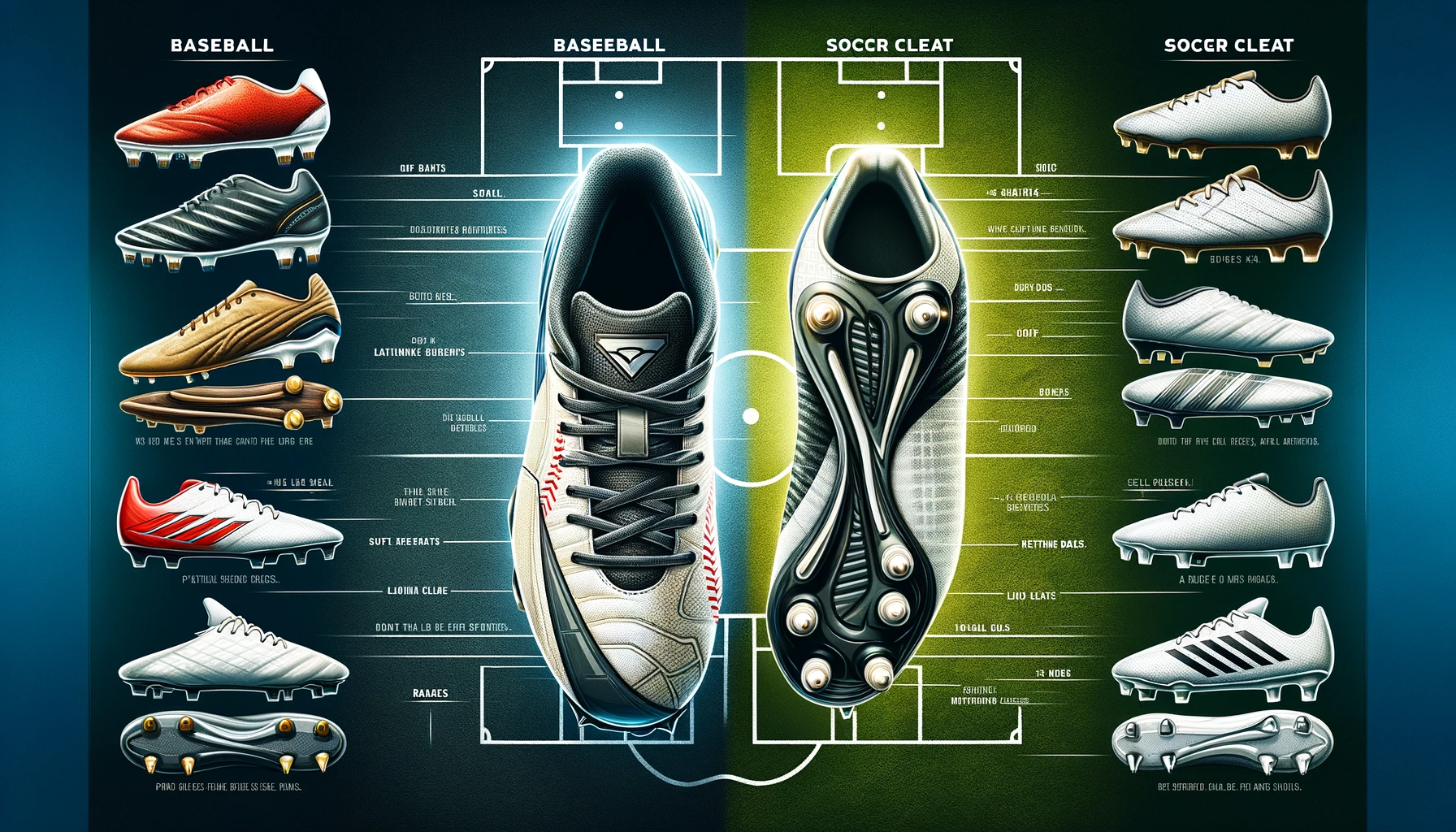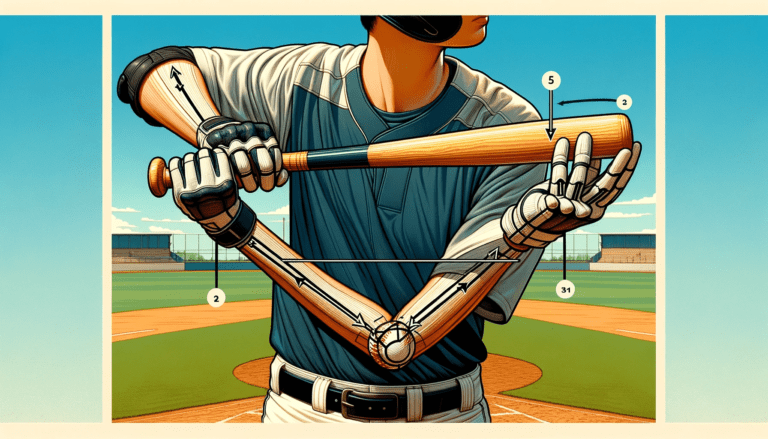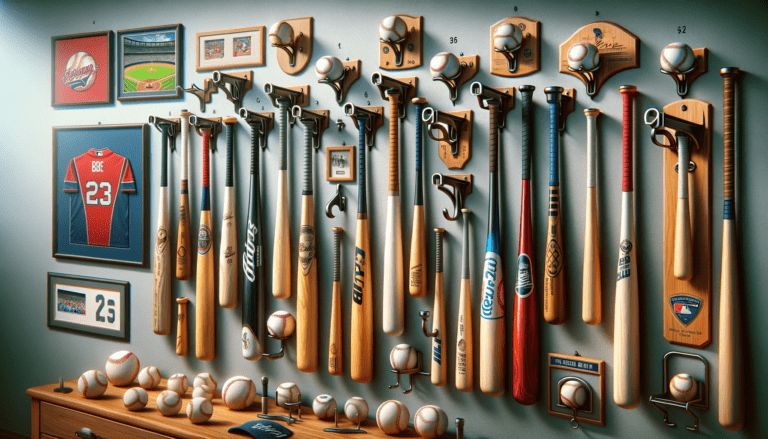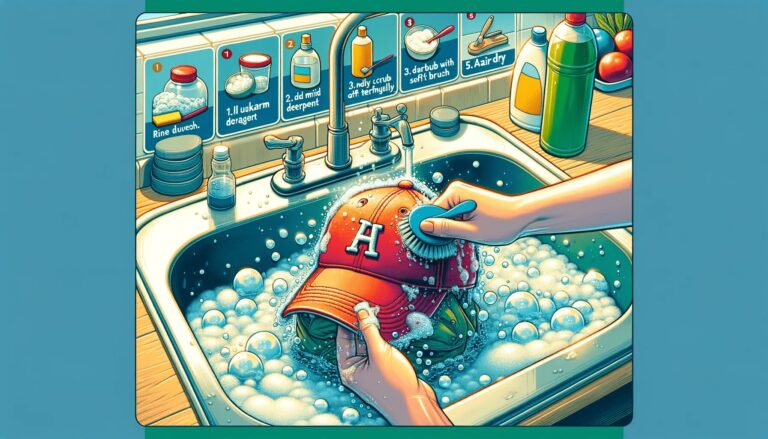What is the Difference Between Baseball Cleats and Soccer Cleats?
Are you confused about which cleats to buy for your favorite sport?
Choosing the wrong type of cleats can lead to discomfort, poor performance, and even injuries. Baseball and soccer cleats may seem similar, but they are designed for different purposes.
Wearing baseball cleats on the soccer field or soccer cleats on the baseball diamond can be a recipe for disaster. You need to understand the specific features and requirements of each sport to make the right choice.
In this article, we’ll explore the key differences between baseball cleats vs soccer cleats, helping you select the perfect pair for your game. Say goodbye to confusion and hello to optimal performance!
Key Takeaways
- Soccer and baseball cleats have distinct designs; soccer cleats are lighter for agility, while baseball cleats feature a toe spike for quick starts.
- Comfort and support are essential, with baseball cleats offering more ankle support and a toe spike for added traction and stability.
- Traction patterns differ greatly; soccer cleats are designed for maneuverability on a field, whereas baseball cleats are optimized for gripping dirt and grass.
- Using soccer cleats for baseball can increase the risk of injury due to the lack of sport-specific features such as adequate ankle support and toe spikes.
- Adhering to league standards is crucial; using the wrong type of cleats can lead to non-compliance with organizational equipment rules.
Design and Construction: Tailored for the Sport
Material and Weight Considerations
Soccer and baseball cleats are designed with specific materials to optimize performance for each sport.
Soccer cleats tend to be lighter, more flexible, facilitating quick movements and agility on the field. An average soccer cleat weighs about 8.6 ounces, which is a testament to the advancements in lightweight materials.
Baseball cleats, on the other hand, prioritize stability and traction, which can result in a slightly heavier build. The choice of materials also reflects the type of playing surfaces each sport uses.
For instance:
- Soccer cleats often use synthetic materials for a combination of lightness and durability.
- Baseball cleats may incorporate more leather, which offers durability and can withstand the diamond’s dirt and grass.
When selecting cleats, it’s important to consider these differences to ensure they align with the demands of the sport and the athlete’s needs.
Cleat Configuration and Toe Spike
The cleat configuration is a critical aspect that differentiates soccer and baseball cleats.
Baseball cleats typically include a toe spike, which aids players in achieving quick starts and sudden stops.
This feature is particularly useful for baseball players who need to make rapid directional changes and accelerate quickly from a standing position.
In contrast, soccer cleats do not have a toe spike. The absence of this element can affect a soccer player’s performance if they attempt to use their cleats for baseball, potentially leading to reduced traction and stability when running bases.
Here’s a quick comparison:
- Baseball cleats: Equipped with a toe spike for enhanced traction.
- Soccer cleats: No toe spike, prioritizing agility over quick starts.
Players must consider how the cleat configuration will impact their performance on the field.
The right choice in cleats is not only a matter of comfort but also a significant factor in an athlete’s safety and effectiveness during the game.
Ankle Support and Stability
In the realm of team sports, the importance of ankle support and stability cannot be overstated, especially when it comes to the dynamic movements in baseball.
Baseball cleats are typically designed with a higher cut to firmly support the ankle during the sport’s characteristic lateral movements and sudden changes in direction.
This design contrasts with soccer cleats, which prioritize flexibility and a lower cut for freedom of movement and ball more.
When selecting cleats, consider the following:
- The cut of the cleat: High-tops for enhanced ankle support, low-tops for increased mobility.
- The fit: Ensure a snug fit to prevent blisters and provide better control.
- The material: Durable materials contribute to the longevity of the cleat and consistent support.
Ultimately, wearing the correct type of cleats tailored to your sport’s specific demands is crucial for performance and injury prevention.
While soccer cleats might be suitable for casual baseball play, they may not meet the requirements for competitive games where the risk of injury is higher and the need for stability is paramount.
Read Also: What is the Difference Between Softball and Baseball Cleats
Comfort and Support: Ensuring Peak Performance
The Importance of Proper Fit
Ensuring a proper fit is not just about comfort; it’s about performance and safety on the field. A well-fitted cleat can make a significant difference in a player’s agility and injury prevention.
When selecting cleats, consider the following:
- Try on multiple sizes with your game-day socks to find the best fit.
- The cleat should be snug but not overly tight, allowing for natural foot movement.
- Pay attention to the width of the cleat as well as the length; both are crucial for a proper fit.
Remember, a poorly fitted cleat can lead to blisters, discomfort, and even long-term foot problems. It’s worth taking the time to find the right size and style for your specific needs.
Cushioning and Arch Support
When selecting cleats, cushioning is a critical factor that directly influences comfort levels and impact absorption during play.
Adequate padding not only provides a plush feel but also helps to reduce the stress on joints caused by running and abrupt movements.
Proper arch support is equally important, as it ensures a stable foundation for the foot. This support is essential for maintaining balance and preventing strain on the arches, which can lead to injuries over time.
Here are some tips for ensuring optimal cushioning and arch support:
- Look for cleats with a well-cushioned midsole that offers both comfort and shock absorption.
- Ensure the insole of the cleat conforms to the natural shape of your foot, providing tailored arch support.
- Consider the materials used in the construction of the cleat, as some provide better cushioning and support than others.
Remember, a well-fitted cleat not only enhances performance but also minimizes the risk of blisters and discomfort. Always try on multiple sizes with your game-day shoes and socks to find the perfect fit.
Breathability and Durability
When selecting soccer or even baseball shoes and cleats, breathability and durability are crucial for both comfort and longevity.
Leather cleats are known for their superior breathability, adapting to the shape of the foot and reducing the likelihood of unpleasant odors after use.
However, synthetic materials offer the advantage of water resistance, keeping feet dry during play.
To ensure your cleats last as long as possible, consider the following tips:
- Clean your cleats after every use with a soft brush to remove dirt and grass.
- Avoid wearing them on hard surfaces to minimize wear and tear.
- Allow cleats to dry naturally, steering clear of direct heat to prevent material damage.
- For leather cleats, use a shoe conditioner to maintain flexibility.
- Store your footwear in a cool, dry environment to ward off mildew and odors.
Ultimately, the choice between leather and synthetic cleats comes down to a balance between personal preference for feel and the practicality of maintenance and durability.
Read Also: What is the Difference Between Football Cleats and Baseball Cleats
Traction and Movement: The Foundation of Agility
Traction Patterns and Surface Grip
The traction provided by cleats is fundamental to a player’s performance on the field. Baseball cleats are designed with specific traction patterns that enable players to grip the dirt and grass effectively, facilitating quick, agile movements and sudden changes in direction.
These patterns are crucial for the stop-and-go nature of baseball, where stability during sprints and lateral movements is essential.
In contrast, soccer cleats often feature conical or bladed studs that cater to the sport’s emphasis on agility and continuous movement.
The stud configuration is optimized for maneuverability on a soccer field, allowing players to twist, turn, and accelerate with ease.
Different types of soccer cleats are tailored for various playing surfaces:
- Firm-ground (FG) cleats for natural grass, with molded studs.
- Artificial Ground (AG) boots for synthetic pitches, with shorter, hollow studs.
- Turf (TPU) soccer cleats for artificial turf, featuring rubber or TPU spikes.
- Indoor soccer shoes with flat rubber soles for hard court surfaces.
Choosing the right cleat for the playing surface not only enhances performance but also reduces the risk of injury.
It’s important to identify your playing needs and select footwear that aligns with the demands of your sport and the conditions of the playing field.
The Role of Cleats in Directional Movement
The role of cleats in directional movement is pivotal for athletes, as they provide the necessary grip and stability required for quick turns and agile maneuvers.
Baseball cleats are designed with a toe spike, which aids in explosive starts and stops, especially when running bases.
This feature is absent in soccer cleats to minimize the risk of injuries during close contact plays such as sliding tackles.
- Soccer cleats prioritize flexibility and a low-cut design to facilitate continuous movement and agility.
- Baseball cleats, with their higher cut, offer additional ankle support for the lateral movements that are characteristic of the sport.
Choosing the right cleats for the intended sport is not just about comfort and performance; it’s also a safety consideration.
Wearing cleats that are not designed for specific movements can lead to decreased performance and an increased risk of injury.
Therefore, understanding the unique demands of each sport is essential when selecting athletic footwear.
Comparing Soccer and Baseball Cleat Soles
When it comes to the soles of soccer and baseball cleats, the distinctions are tailored to each sport’s unique demands.
Baseball cleats often include a toe spike, which provides players with the necessary traction for quick starts and sudden stops. This feature is particularly useful when running bases or fielding.
Soccer cleats, on the other hand, prioritize agility and constant movement, which is reflected in their sole design.
They typically lack a toe spike, allowing for a smoother transition during continuous play. Players may find that soccer cleats offer a different level of traction on the pitch, which can influence their speed and control.
Understanding these differences is crucial for athletes to ensure they are equipped with the right type of cleat for their sport.
Whether it’s the stability and control offered by baseball cleats or the lightweight agility of soccer cleats, selecting the appropriate footwear is a step toward achieving peak performance.
Safety and Injury Prevention: Choosing the Right Cleats
Risk Factors of Cross-Usage
Using the wrong type of cleats for a sport can lead to a range of issues. Soccer cleats are designed for agility and speed, while baseball cleats are tailored for traction and stability on the diamond.
When athletes use soccer cleats for baseball, they may encounter several risk factors:
- Inadequate ankle support can increase the chance of sprains or injuries, as soccer cleats are generally lower cut compared to the high-ankle design of baseball cleats.
- The absence of a toe spike on soccer cleats can affect balance and traction during baseball, leading to slips or falls.
- The lighter construction of soccer cleats may not withstand the rigors of baseball, potentially resulting in premature wear or equipment failure.
It’s crucial to recognize that each sport has its unique demands and using the correct equipment is essential for safety and performance.
The mismatch in cleat design can lead to unexpected accidents and injuries, emphasizing the importance of sport-specific gear.
Injury Risks Associated with Improper Cleats
Wearing the wrong type of cleats can lead to a higher risk of injury, as they are not designed to accommodate the specific movements and stresses of different sports.
Baseball players, for instance, require cleats that offer additional ankle support and a toe spike for traction, which soccer cleats lack. This mismatch in design can result in accidents and injuries such as sprains or fractures.
Key factors to consider include:
- The need for higher ankle support in baseball cleats to prevent rollovers during lateral movements.
- The presence of a toe cleat in baseball shoes for digging into the dirt during batting and fielding.
Ignoring these differences not only hampers performance but also exposes athletes to a variety of injuries.
From the minor, such as blisters and discomfort, to the more severe, like sprained fingers or even broken bones, the consequences of using improper footwear are significant.
Players must select cleats that are specifically tailored to their sport’s requirements to ensure safety on the field.
The Significance of Sport-Specific Equipment
The right equipment can make a significant difference in an athlete’s performance and safety.
Properly fitting and sport-specific shoes are integral to success in many sports, including soccer and baseball.
Each sport has its own set of demands that dictate the design and functionality of its gear.
- Soccer cleats are designed for continuous running and quick directional changes on a grassy surface.
- Baseball cleats, on the other hand, need to accommodate short bursts of speed, lateral movements, and traction on dirt and grass.
Using the wrong type of cleats can not only hinder performance but also increase the risk of injury.
It’s essential to choose the right cleats that are tailored to the specific requirements of the sport you are playing. This ensures not only better performance but also greater protection against potential injuries.
Regulatory Compliance: Adhering to League Standards
Understanding Organizational Equipment Rules
Each sports organization has specific rules regarding the equipment that players can use during official games and events.
Understanding these rules is crucial for referees and athletes to avoid penalties and ensure fair play.
- Familiarize yourself with the league’s equipment guidelines.
- Check for updates before the start of each season.
- Consult with team officials or coaches if you have any doubts.
Adherence to equipment rules not only keeps the game fair but also ensures that all players are on a level playing field.
Players and parents need to remember that non-compliance can lead to disqualification or other disciplinary actions.
Therefore, investing time in understanding and following these rules is essential for every competitive athlete.
Consequences of Non-Compliance
Failing to adhere to league standards for cleats can lead to a series of repercussions for players and teams alike.
Non-compliance may result in penalties such as fines, suspension, or even disqualification from games.
These consequences are not just limited to the players; teams can also face sanctions, which might include forfeiture of games or points. The impact of non-compliance extends beyond immediate penalties.
Players who wear non-regulatory cleats may also suffer from a lack of endorsement opportunities or face negative publicity.
As seen in the case of the Yankees pitcher with his unusual blue denim cleats. This can tarnish a player’s reputation and affect their career in the long term.
To avoid these outcomes, it is crucial for players to:
- Understand the equipment rules set by their league.
- Ensure their cleats are compliant before stepping onto the field.
- Regularly check for updates to the rules, as they can change from season to season.
How to Choose Cleats Within Regulation Guidelines
Selecting the right cleats within regulation guidelines is essential for both compliance and performance.
Start by familiarizing yourself with the specific rules and requirements of your league or association.
These regulations often detail permissible materials, cleat length, and whether toe spikes are allowed.
- Consult the official rulebook or league website for detailed equipment standards.
- Check with your coach or equipment manager to ensure your choice is compliant.
- Consider the playing surface and choose cleats designed for optimal traction and safety on that terrain.
Remember, while comfort and style are important, the primary goal is to select cleats that meet regulatory standards and support your performance on the field.
Failure to adhere to these guidelines can result in penalties or disqualification, so take the time to make an informed decision.
Conclusion
In summary, while soccer and baseball cleats may appear similar, their distinct design features cater to the specific needs of each sport.
Soccer cleats prioritize agility and lightness, lacking a toe spike, which is a critical element in baseball cleats for effective acceleration and traction.
The choice of the right cleats is not just a matter of comfort and support, but also a significant factor in performance and safety.
Athletes must consider these differences to prevent injury and ensure compliance with organizational rules.
Ultimately, understanding and selecting the appropriate footwear is essential for any player looking to excel on the field, whether it’s the soccer pitch or the baseball diamond.
Frequently Asked Questions
Can soccer cleats be used for playing baseball?
While soccer cleats can be physically worn for baseball, they are not designed for the sport’s specific needs, such as a toe spike for quick starts, and may not provide the same level of performance and safety.
What are the main differences between soccer and baseball cleats?
Soccer cleats are generally lighter and designed for agility without a toe spike, while baseball cleats have a toe spike for better traction during quick starts and stops, and often provide more ankle support.
Why is a toe spike important in baseball cleats?
A toe spike in baseball cleats provides additional traction, allowing players to dig into the dirt for quick starts and sudden movements, which is crucial for performance on the baseball diamond.
Can wearing the wrong type of cleats lead to injuries?
Yes, wearing cleats not designed for the specific demands of a sport can increase the risk of injury due to a lack of proper support, stability, and traction.
Are there any rules against using soccer cleats for baseball?
Sports organizations may have strict equipment regulations, and using soccer cleats for baseball could potentially violate these rules. It’s important to check with your league’s equipment guidelines.
How do I choose the right cleats for my sport?
Choose cleats that are specifically designed for your sport, considering factors like cleat configuration, material, support, and compliance with league regulations to ensure optimal performance and safety.







